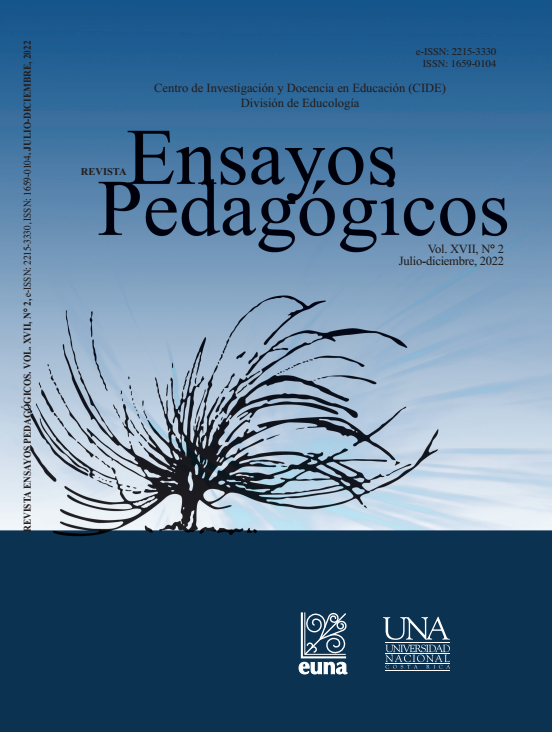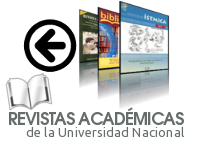A Comparison of the Program Escuelas Promotoras de Paz on Self-Efficacy towards Physical Activity among School Students of Honduras and Nicaragua
DOI:
https://doi.org/10.15359/rep.17-2.7Keywords:
children, intervention, physical education, recessAbstract
The objective of the study was to compare the effect of the intervention called Escuelas Promotoras de Paz towards the self-efficacy of students in two schools in Central American countries, Honduras and Nicaragua. The participants in this study were 216 schoolchildren, (n = 108 in each country) between ages 8 and 13 (10.49 ± 0,95 years of age). The self-efficacy questionnaire towards physical activity was administered to the participants (Aedo & Ávila, 2009). In this intervention, the Ecological Model was used based on physical education classes twice a week; active and organized recesses were developed with social support to promote physical activity for students. It was found that Honduran schoolchildren had a worse perception of self-efficacy than Nicaraguan students. It was also evidenced that girls, regardless of their country, presented better self-efficacy than boys, perceiving themselves to be more successful when doing the physical activities included in the intervention. The perceived self-efficacy of boys decreased over the course of the study, while girls remained stable or tended to improve their self-efficacy. Future studies should consider the differentiated response by sex in this variable to generate more effective interventions.
References
Aedo, A., y Ávila, H. (2009). Nuevo cuestionario para evaluar la autoeficacia hacia la actividad física en niños. Revista Panamericana de Salud Pública, 26(4), 324-329. https://iris.paho.org/bitstream/handle/10665.2/9763/v26n4a06.pdf?sequence=1&isAllowed=y
Álvarez, C., Herrera, M., Herrera, E., Villalobos, G., y Araya, G. (2019). Sobrepeso, obesidad, niveles de actividad física y autoestima de la niñez centroamericana: un análisis comparativo entre países. Retos, 37, 238-246. https://recyt.fecyt.es/index.php/retos/article/view/71680
Álvarez, C. (2016a). Efectividad del programa ecológico Saltando por su salud en la promoción de la actividad física y la auto-eficacia en niños y niñas escolares de tercer grado. Revista Ensayos Pedagógicos, 11(1), 147-169. https://doi.org/10.15359/rep.11-1.8
Álvarez, C. (2016b). Entendiendo los factores que determinan la actividad física en el entorno escolar desde la perspectiva de los niños y niñas. MHSalud: Revista en Ciencias del Movimiento Humano y Salud, 13(1), 1-17. http://dx.doi.org/10.15359/mhs.13-1.2
Bandura, A. (1997). Self-efficacy: The exercise of control. Freeman.
Bortoli L., y Robazza C. (1997). Italian Version of the Perceived Physical Ability Scale. Perceptual and Motor Skills, 85(1), 187-192. https://journals.sagepub.com/doi/10.2466/pms.1997.85.1.187
Bonell, C. P., Fletcher, A., Jamal, F., Wells, H., Harden, A., Murphy, S., y Thomas, J. (2013). Theories of how the school environment impacts on student health: Systematic review and synthesis. Health and Place, 24, 242–249. https://doi.org/10.1016/j.healthplace.2013.09.014
Cataldo, R., John, J., Chandran, L., Pati, S., y Shroyery Shroyer, A. L. W. (2013). Impact of Physical Activity Intervention Programs on Self-Efficacy in Youths: A Systematic Review. ISRN Obesity, 2013, 1–11. https://doi.org/10.1155/2013/586497
Cigarroa, I., Sarqui, C., y Zapata, R. (2016). Efectos del sedentarismo y obesidad en el desarrollo psicomotor en niños y niñas: Una revisión de la actualidad latinoamericana. Universidad y Salud, 18(1), 156. https://doi.org/10.22267/rus.161801.27
Demetriou, Y., y Höner, O. (2012). Physical activity interventions in the school setting: A systematic review. Psychology of Sport and Exercise, 13(2), 186–196. https://doi.org/10.1016/j.psychsport.2011.11.006
Eime, R. M., Young, J. A., Harvey, J. T., Charity, M. J., y Payne, W. R. (2013). A systematic review of the psychological and social benefits of participation in sport for children and adolescents: Informing development of a conceptual model of health through sport. International Journal of Behavioral Nutrition and Physical Activity, 10(98), 1-21. http://www.ijbnpa.org/content/10/1/98
Geller, K. S., y Dzewaltowski, D. A. (2010). Examining elementary school-aged children’s self-efficacy and proxy efficacy for fruit and vegetable consumption. Health Education and Behavior, 37(4), 465–478. https://doi.org/10.1177/1090198109347067
Goh, T. L., Hannon, J., Webster, C., Podlog, L., y Newton, M. (2016). Effects of a TAKE 10! Classroom-Based Physical Activity Intervention on Third- to Fifth-Grade Children’s On-task Behavior. Journal of Physical Activity and Health, 13(7), 712-718. https://doi.org/10.1123/jpah.2015-0238
Hesketh, K. R., Lakshman, R., y Van Sluijs, E. M. F. (2017). Barriers and facilitators to young children’s physical activity and sedentary behaviour: a systematic review and synthesis of qualitative literature. Obesity Reviews, 18(9), 987–1017. https://doi.org/10.1111/obr.12562
Hynynen, S., Stralen, M. M., Sniehotta, F. F., Araújo-Soares, V., Hardeman, W., Chinapaw, M., Vasankari, T., y Hankonen, N. (2015). A systematic review of school-based interventions targeting physical activity and sedentary behaviour among older adolescents. International Review of Sport and Exercise Psychology, 9(1), 22-44. https://doi.org/10.1080/1750984X.2015.1081706
Ishii, K., Shibata, A., Sato, M., y Oka, K. (2014). Recess physical activity and perceived school environment among elementary school children. International Journal of Environmental Research and Public Health, 11(7), 7195-7206. https://doi.org/10.3390/ijerph110707195
Ickes, M. J., Erwin, H., y Beighle, A. (2016). Systematic Review of Recess Interventions to Increase Physical Activity. Journal of Physical Activity and Health, 10(6), 910–926. https://doi.org/10.1123/jpah.10.6.910
Jauregui U., E., López T., J., Macías S., A. N., Porras R., S., Reynaga E., P., Morales A., J. J. y Cabrera G., J. L. (2013). Autoeficacia y Actividad Física en Niños Mexicanos con Obesidad y Sobrepeso. Sport TK. Revista Euroamericana de Ciencias del Deporte, 2(2), 69-75. https://doi.org/10.6018/194641
Kain, J., Uauy, R., Leyton, B., Cerda, R., Olivares, S., y Vio F. (2008). Efectividad de una intervención en educación alimentaria y actividad física para prevenir obesidad en escolares de la ciudad de Casablanca, Chile (2003-2004). Revista Médica Chilena, 136, 22-30. http://dx.doi.org/10.4067/S0034-98872008000100003
Kibbe, D. L., Hackett, J., Hurley, M., McFarland, A., Schubert, K. G., Schultz, A., y Harris, S. (2011). Ten Years of TAKE 10!®: Integrating physical activity with academic concepts in elementary school classrooms. Preventive Medicine, 52(Suppl.), S43–S50. https://doi.org/10.1016/j.ypmed.2011.01.025
Lox, C., Martín, K. y Petruzzello, S. (2006). The Psychology of Exercise. HHP.
Maôano, C., Ninot, G., y Bilard, J. (2004). Age and Gender Effects on Global Self-Esteem and Physical Self-Perception in Adolescents. European Physical Education Review, 10(1), 53-69. https://doi.org/10.1177/1356336X04040621
Martínez, J., Castillo, L., y Granda, V. (2017).Formación inicial del docente de educación física y su desempeño profesional. EmásF: Revista Digital de Educación Física, 48, 83-95. https://dialnet.unirioja.es/servlet/articulo?codigo=6121667
Morano, M., Bortoli, L., Ruiz, M. C., Vitali, F., y Robazza, C. (2019). Self-efficacy and enjoyment ofenjoyment of physical activity in children: Factorial validity of two pictorial scales. PeerJ, 7, 1–12. https://doi.org/10.7717/peerj.7402
Organización Mundial de la Salud (OMS). (2020). Obesidad y Sobrepeso. Reporte. https://www.who.int/es/news-room/fact-sheets/detail/obesity-and-overweight
Parrish, A., Okely, A. D., Stanley, R. M. y Ridgers, N. (2013). The Effect of School Recess Interventions on Physical Activity. Sports Med, 43, 287–299. https://doi.org/10.1007/s40279-013-0024-2
Pawlowski, C. S., Tjørnhøj-Thomsen, T., Schipperijn, J., y Troelsen, J. (2014). Barriers for recess physical activity: A gender specific qualitative focus group exploration. BMC Public Health, 14(1), 1–10. https://doi.org/10.1186/1471-2458-14-639
Peterson, S. E., y Miller, J. A. (2004). Comparing the Quality of Students' Experiences During Cooperative Learning and Large-Group Instruction. The Journal of Educational Research, 97(3), 123-134. https://doi.org/10.3200/JOER.97.3.123-134
Reyes, R., Otero, E., Pastrán, R., Herrera-Monge, M. F. y Álvarez, C. (2018). Análisis del sobrepeso, obesidad, niveles de actividad física y autoestima de la niñez de León, Nicaragua. MHSalud, 16(1), 1-15. https://doi.org/10.15359/mhs.16-1.4
Ridgers, N. D., Fairclough, S. J., y Stratton, G. (2010). Twelve-month effects of a playground interventionplayground intervention on children’s morning and lunchtime recess physical activity levels. Journal of Physical Activity and Health, 7(2), 167-175. https://doi.org/10.1123/jpah.7.2.167
Saint-Maurice, P. F., Welk, G. J., Beyler, N. K., Bartee, R. T., y Heelan, K. A. (2014). Calibration of self-report tools for physical activity research: The Physical Activity Questionnaire (PAQ). BMC Public Health, 14(1), 1-9. http://www.biomedcentral.com/1471-2458/14/461
Sallis, J., McKenzie, T. L., Alcaraz, J., Kolody, B., Faucette, N., y Hovell, M. (1997). The effects of a 2-year physical education program (SPARK) on physical activity and fitness in in elementary school students. Sports, Play and Active Recreation for Kids. American Journal of Public Health, 87(8), 1328-1334. https://doi.org/10.2105/AJPH.87.8.1328
Salmon, J. y Timperio, A. (2007). Prevalence, trends and environmental influences on child and youth physical activity. Medicine and Sport Science, 50, 183-199. https://doi.org/10.1159/000101391
Sarkin, J. A., McKenzie, T. L., y Sallisy Sallis, J. F. (1997). Gender differences in physical activity during fifthgrade physical education and recess period. Journal of Teaching Physical Education, 17(1), 99-106. https://doi.org/10.1123/jtpe.17.1.99
Spence, J. C., Blanchard, C. M., Clark, M., Plotnikoff, R. C., Storey, K. E., y McCargar, L. (2010). The role of self-efficacy in explaining gender differences in physical activity among adolescents: A multilevel analysis. Journal of Physical Activity and Health, 7(2), 176–183. https://doi.org/10.1123/jpah.7.2.176
Trigueros, R., Navarro, N., Aguilar, J., y León, I. (2019). Influencia del docente de Educación Física sobre la confianza, diversión, la motivación y la intención de ser físicamente activo en la adolescencia. Cuadernos de Psicología del Deporte, 19(1), 222-232. https://revistas.um.es/cpd/article/view/347631/256811
Van Sluijs, E., McMinn A., y Griffin S. (2008). Effectiveness of interventions to promote physical activity in children and adolescents: systematic review of controlled trials. BMJ, 42(8), 653-657. https://doi.org/10.1136/bmj.39320.843947.BE
Vásquez-Bonilla, A., Zelaya-Paz, C., y García- Aguilar, J. (2019). Análisis de sobrepeso y obesidad, niveles de actividad física y autoestima en escolares de San Pedro Sula, Honduras. MHSalud Revista en Ciencias del Movimiento Humano y Salud, 16(2), 1-14. http://dx.doi.org/10.15359/mhs.16-2.5
Ward, D., Saunders, R., y Pate, R. (2007). Physical Activity Interventions in Children and Adolescents. Human Kinetics Publishers.
Willenberg, L. J., Ashbolt, R., Holland, D., Gibbs, L., Macdougall, C., Garrard, J., Green, J. y Waters, E. (2010). Increasing school playground physical activity: A mixed methods study combining environmental measures and children's perspectives. Journal of Science and Medicine in Sport, 13(2), 210-216. https://doi.org/10.1016/j.jsams.2009.02.011
Published
How to Cite
Issue
Section
License
Ensayos Pedagógicos is subscribed to the Attribution-NonCommertial-NoDerivatives 4.0 International Creative Commons Licence, which allows both authors and readers to freely download, store, copy, and distribute the final approved publisehd version of the manuscript (post-print) as long as this is done without commercial purposes, no derivative works are generated, and the source and author are mentioned. As well, Ensayos Pedagógicos declares that authors will remain the rightful owners of the copyrights of their work in perpetuity.







